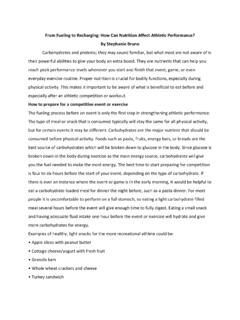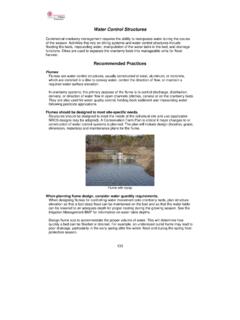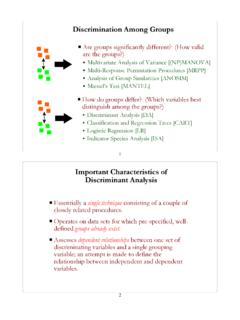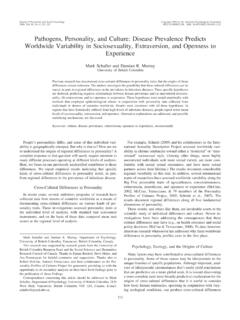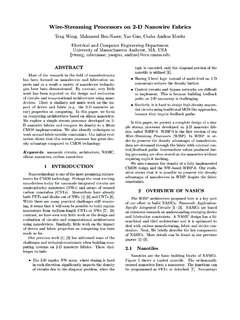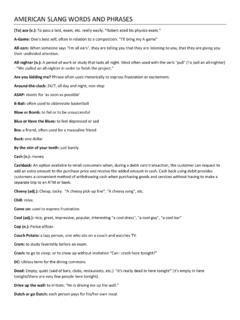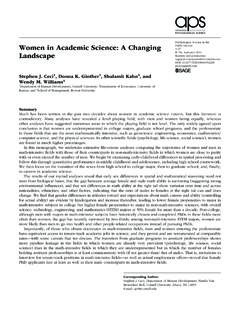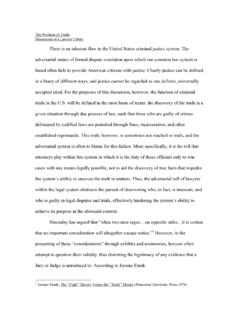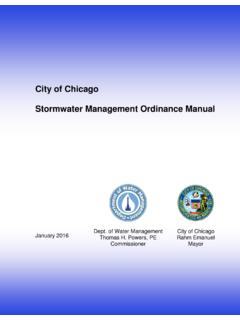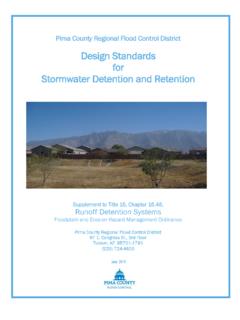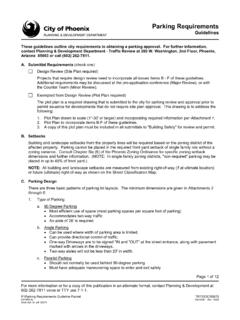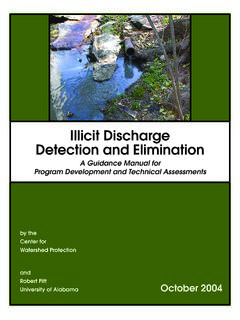Transcription of DATA ANALYSIS SUMMARY - UMass
1 data ANALYSIS SUMMARY The following data ANALYSIS SUMMARY is the result of a project funded by the Massachusetts Environmental Trust. The overall goal of this project is to develop a transferable process of cost-effective water quality data ANALYSIS leading to improved volunteer monitoring practices and the development of effective lake management strategies. Through this process a unique panel of experts was convened including, Dr. Steve Souza of Princeton Hydro LLC., Dr. Dave Mitchell with Dr. Ken Wagner of ENSR, Dr. C. Barre Hellquist of the Massachusetts College of Liberal Arts, Dr. Paul Godfrey of the University of Massachusetts, and Jerry Schoen Statewide Coordinator of the Massachusetts Water Watch Partnership. The panel reviewed and analyzed water quality data in order to evaluate environmental monitoring practices and the ecological health of a particular water body.
2 The project utilized a case-study approach using prior water quality monitoring data from Onota Lake, collected by volunteers from the Lake Onota Preservation Association (LOPA) and paid consultants. LOPA is a model of the progress that volunteer monitors have begun to make. LOPA has collected years of water quality data , has collaborated with the City of Pittsfield, has begun several implementation projects, and has completed a DEP/EPA Approved Quality Assurance Project Plan (QAPP). For these reasons Onota Lake serves as an excellent model of what volunteer water quality monitors can accomplish. data from Onota Lake will be also be incorporated as a case study/template into the data Interpretation Manual developed by MassWWP. Incorporating data reviewed by the scientific advisory panel into this statewide manual will expand the manual to include an example that will be able to be used by volunteers in their efforts to analyze their own data .
3 Through this project, data from Onota Lake was reviewed and analyzed independently by members of a scientific advisory panel after which the panel members convened at a one day conference and discussed and dissected the data explaining what it means for management actions and future monitoring needs. The following is a SUMMARY of the recommendations of the data ANALYSIS conference. Evaluate and prioritize negative impacts to the use and enjoyment of the lake. This may include: Weed growth Algae scums or mats Poor fishing Reduced clarity Shoreline erosion Decline in aesthetics The Golden Rule Of Successful Lake management Don t Just Treat The Correct the Cause For a management and Restoration Plan to be successful it must: 1. Be objective and based on sound data 2. Have clearly defined goals and objectives 3. Have the support and backing of the membership, community and regulatory authorities Numeric data (water quality data , profiles) Biological community data (species, abundance) Descriptive material (geology, climate) Socioeconomic (land use, zoning, political) Diagnostic / Feasibility Study for Onota Lake, Pittsfield, MA, IT Corporation, March 1991, Principal Investigator Dr.
4 Steve Souza Environmental Impact Review and Managerial Implications for a Proposed Drawdown of Onota Lake, Pittsfield, MA, Fugro East, Inc., July 1996, Principal Investigator Dr. Ken Wagner Onota Lake Monitoring Program, 1997, American Lakes & Wetlands Services, Inc., Principal Investigator Sean Lonergan Onota Lake SUMMARY of Previous Recommendations for Lake management , Prepared by Lake Onota Preservation Association, 1998 Onota Lake management Plan, 1999, Prepared by Lake Onota Preservation Association (LOPA) 1996 data SUMMARY , Prepared by Lake Onota Preservation Association (LOPA) 1997 data SUMMARY , Prepared by Lake Onota Preservation Association (LOPA) LOPA Volunteer Monitoring Program, 1998 Report, Prepared by Robert W. Race Re: Onota Lake Water Testing, Aquatic Control Technology, Inc., August 19, 1999 Re: Onota Lake Nuisance Aquatic Vegetation management Program - Year One Update (1999), Aquatic Control Technology, Inc.
5 , October 25, 1999 LOPA Volunteer Monitoring Program 1999 SUMMARY Report, Prepared by Robert W. Race LOPA Volunteer Monitoring Program 2000 Annual Report, Prepared by R. Race, B. Winn, and J. Winn Long-range Aquatic Vegetation management Plan Onota Lake Pittsfield, MA, Aquatic Control Technology, Inc., December 2000 Presentation Material, LOPA Robert W. Race, September 2000 LOPA Sedimentation Report Relevant Information & Reports on Onota Lake Reports can be broken down into 4 information types PAGE 2 data ANALYSIS SUMMARY Identify Relevant Information & Reports ~~~~~~~~~~~~~~~~~~~~~~~~~~~~~~~~~~~~~~~~ ~~~~~~~~~~~~~~~~~~~~~~~~~~~~~~~~~~~~~~~~ ~~~~~~~~~~~~~~~~~~~~~~~~~~~~~~~~~~~~~~~~ ~~~~~~~~~~~~~~~~~~~~~~~~~~~~~~~~~~~~~~~~ PAGE 3 data ANALYSIS SUMMARY Focus or Prioritize material or sections among the volunteers Lake and Watershed Setting Onota Lake behaves as if it is two lakes in one.
6 The North Basin is an impoundment created by the Onota Lake Dam while the South Basin remains the naturally formed lake. The two basins have extremely different characteristics. In basic terms, the lake overall is large and deep. Onota Lake Morphology Lake Area 250 ha Max Depth m Mean Depth m Max Volume m3 Watershed Area km2 Shoreline Length km Max width km Max length km The Lake and Watershed Setting can be determined by: Surface Area and Lake Morphology Bathymetric Map Watershed and Land Use Map/ ANALYSIS Seasonal Dissolved Oxygen and Temperature Profile Seasonal dissolved oxygen and temperature profiles are determined by examining: Seasonal profile for temperature and dissolved oxygen showing the seasonal progression of thermocline deepening and loss of dissolved oxygen Evaluate your lake database by examining.
7 Sampling Locations Sampling Parameters, Duration and Frequency data Quality (lab results below detection limits may mean that the laboratory is not able to meet your needs) Examine the hydrologic budget to determine where the water comes from, how much and how fast by: Major inputs/outputs Flushing rate/variation Water level fluctuations Lake Database Evaluation Hydrologic Budget Onota Lake has had a wide range of studies, including a formal Diagnostic Feasibility Study, that make up its lake database. In addition to studies, Onota Lake has several years of volunteer monitoring data to add to its database. Inputs 106m3/yr Tributary and Surface Runoff Inputs Precipitation directly on lake surface corrected for evaporation Ground Water Recharge and subsequent influx of surplus to tributaries Direct seepage of ground water to lake Total Input Budget Outputs Total Annual Outflow Onota Lake Hydrologic Budget, from Table of the Diagnostic Feasibility Study Note: The following section outlines a general method of review and presents Onota Lake data as an example.
8 PAGE 4 data ANALYSIS SUMMARY Focus or Prioritize A trophic state ANALYSIS integrates the results of the water quality, morphology, hydrologic and nutrient loading studies by examining there is both a permissible and critical load: Phosphorus and nitrogen fraction levels Chlorophyll (peak, mean levels) Secchi disk transparency and seasonal trends Trophic State ANALYSIS results in an ANALYSIS of the use impairment Onota Lake Trophic State ANALYSIS Table of Diagnostic Feasibility Study Annual Load kg/yr Areal Load g/m2/yr TP Retention Hydraulic Retention Time yr Mean Depth m Note: Calculations can be found in D/F Study. The internal loading is different in the two basins of Onota Lake.
9 The trophic state of the north basin is mesotrophic to eutrophic while the trophic state of the south basin is mesotrophic to oligotrophic. Biological community indicators include: Phytoplankton - counts, species, groups Macrophyte - cover, abundance, composi-tion Riparian vegetation/wetlands - location, type Fish and invertebrate communities- species abundance Biological Community Indicators Onota lake is represented by an assemblage of aquatic plants. Many species are represented, and while some species are abundant no species are dominant. Native species are not as much of a concern as exotic species. Two species of macrophytes, Eurasian watermilfoil and curly leaf pondweed have been problems in the north basin. Alkaline lakes, like Onota Lake, are common in the Berkshire area and are likely to have rare species. In order to make management decisions based on the aquatic plant community it is important to understand the life cycles of each species and how they reproduce.
10 Some plant species may come and go without indicating changes in the overall health of the lake. Understanding when certain species are abundant and why will provide information about the health of the lake. Examine the nutrient budget by: Major Total Phosphorus and Total Nitrogen sources Internal vs. external loading Source Total Phosphorus (kg/yr) Total Nitrogen (kg/yr) Suspended Solids (kg/yr) Runoff 7297 x 106 100% Internal - - - Septic 768 - Precipitation 2500 - Dryfall 1028 - Total 1, 11, x 106 Onota Lake Nutrient Budget, from Diagnostic Feasibility Study Nutrient Budget The majority of the total phosphorus enters Onota Lake via runoff. However, Onota Lake also has a sizable internal load of phosphorus. Note Septic load should now be significantly reduced since nearly 100% of the shoreline is now sewered.

